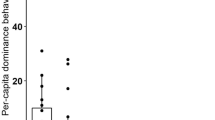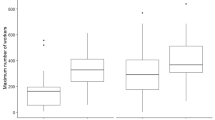Summary
In a queenright colony of the monogynous slave-making ant Harpagoxenus sublaevis, a subset of workers formed a linear dominance order in which dominance was corrlated with ovarian development, frequency of trophallaxis, length of time spent in the nest, but not body size. Identical dominance orders occurred in queenless colonies. Experiments in which the top-ranking workers were removed from queenless colonies demonstrated that worker dominance behaviour inhibits egg-laying in subordinates. A similar removal experiment showed queens restrict dominance behaviour and egg-laying in workers, probably pheromonally. Observations of slave raids indicated ovary-developed workers spent significantly less time scouting for slaves, and tended to participate less in slave raids, than workers without ovarian development. These findings suggest that potentially fertile H. sublaevis workers aggressively compete for egg-laying rights, consume extra food for egg development, and safeguard their reproductive futures by avoiding risks outside the nest. Hence worker reproduction in this species strongly influences the colony's social structure, nutrient flow, and division of labour, even though all workers in a colony are full sisters. I hypothesize that worker reproduction was formerly even more prevalent in H. sublaevis, with workers following the strategy of raising sisters and producing sons predicted by kinship theory. Its continued existence despite queen opposition conceivably results from selection on orphaned workers to reproduce, and the inability of slave-maker workers to raise female-biased broods. The social organization of H. sublaevis therefore highlights the importance both of worker reproduction and of the concomitant queen-worker conflict over male parentage in Hymenopteran social evolution.
Similar content being viewed by others
References
Aoki K, Moody M (1981) One and two-locus models of the origin of worker behavior in Hymenoptera. J Theor Biol 89:449–474
Bartz SH (1982) On the evolution of male workers in the Hymenoptera. Behav Ecol Sociobiol 11:223–228
Bhatkar A, Whitcomb WH (1970) Artificial diet for rearing various species of ants. Fla Entomol 53:229–232
Bourke AFG (1988) Worker reproduction in the higher eusocial Hymenoptera. Q Rev Biol (in press)
Bourke AFG, Have TM van der, Franks NR (1988) Sex ratio determination and worker reproduction in the slave-making ant Harpagoxenus sublaevis. Behav Ecol Sociobiol 23:233–245
Brian MV (1980) Social control over sex and caste in bees, wasps and ants. Biol Rev 55:379–415
Buschinger A (1966a) Untersuchungen an Harpagoxenus sublaevis Nyl (Hym Formicidae). I. Freilandbeobachtungen zu Verbreitung und Lebensweise. Insectes Soc 13:5–16
Buschinger A (1966b) Untersuchungen an Harpagoxenus sublaevis Nyl (Hym, Formicidae). II. Haltung und Brutaufzucht. Insectes Soc 13:311–322
Buschinger A (1968) Untersuchungen an Harpagoxenus sublaevis Nyl (Hymenoptera, Formicidae). III. Kopula, Koloniegründung, Raubzüge. Insectes Soc 15:89–104
Buschinger A (1973) The role of daily temperature rhythms in brood development of ants of the tribe leptothoracini (Hymenoptera; Formicidae). In: Wieser W (ed) Effect of temperature on ectothermic organisms. Springer, Berlin Heidelberg New York, pp 229–232
Buschinger A (1974) Experimente und Beobachtungen zur Gründung und Entwicklung neuer Sozietäten der sklavenhaltenden Ameise Harpagoxenus sublaevis (Nyl). Insectes Soc 21:381–406
Buschinger A (1981) Biological and systematic relationships of social parasitic Leptothoracini from Europe and North American. In: Howse PE, Clément J-L (eds) Biosystematics of social insects. Academic Press, London New York, pp 211–222
Buschinger A, Alloway TM (1978) Caste polymorphism in Harpagoxenus canadensis MR Smith (Hym, Formicidae). Insectes Soc 25:339–350
Buschinger A, Alloway TM (1979) Sexual behaviour in the slave-making ant, Harpagoxenus canadensis MR Smith, and sexual pheromone experiments with H. canadensis, H. americanus (Emery), and H. sublaevis (Nylander) (Hymenoptera; Formicidae). Z Tierpsychol 49:113–119
Buschinger A, Ehrhardt W, Winter U (1980) The organization of slave raids in dulotic ants — a comparative study (Hymenoptera: Formicidae). Z Tierpsychol 53:245–264
Buschinger A, Winter U (1975) Der Polymorphismus der sklavenhaltenden Ameisc Harpagoxenus sublaevis (Nyl). Insectes Soc 22:333–362
Buschinger A, Winter U (1977) Rekrutierung von Nestgenossen mittels Tandemlaufen bei Sklavenraubzügen der dulotischen Ameise Harpagoxenus sublaevis (Nyl). Insectes Soc 24:183–190
Buschinger A, Winter U (1978) Echte Arbeiterinnen, fertile Arbeiterinnen und sterile Wirstweibchen in Völkern der dulotischen Ameise Harpagoxenus sublaevis (Nyl) (Hym, Form). Insectes Soc 25:63–78
Cole BJ (1981) Dominance hierarchies in Leptothorax ants. Science 212:83–84
Cole BJ (1986) The social behavior of Leptothorax allardycei (Hymenoptera, Formicidae): time budgest and the evolution of worker reproduction. Behav Ecol Sociobiol 18:165–173
Dartigues D, Passera L (1979) La ponte des ouvrières chez la fourmi Campanotus aethiops Latreille (Hym Formicidae). Ann Soc Entomol Fr 15:109–116
Fletcher DJC, Ross KG (1985) Regulation of reproduction in eusocial Hymenoptera. Ann Rev Entomol 30:319–343
Franks NR, Scovell E (1983) Dominance and reproductive success among slave-making worker ants. Nature 304:724–725
Hamilton WD (1964) The genetical evolution of social behaviour I, II. J Theor Biol 7:1–52
Hamilton WD (1972) Altruism and related phenomena, mainly in social insects. Ann Rev Ecol Syst 3:193–232
Iwasa Y (1981) Role of sex ratio in the evolution of eusociality in haplodiploid social insects. J Theor Biol 93:125–142
Moritz RFA, Hillesheim E (1985) Inheritance of dominance in honeybees (Apis mellifera capensis Esch). Behav Ecol Sociobiol 17:87–89
Nonacs P (1986) Ant reproductive strategies and sex allocation theory. Q Rev Biol 61:1–21
Pamilo P (1984) Genetic relatedness and evolution of insect sociality. Behav Ecol Sociobiol 15:241–248
Smeeton L (1982) The effect of larvae on the production of reproductive eggs by workers of Myrmica rubra L (Hym Formicidae). Insectes Soc 29:455–464
Stuart RJ, Alloway TM (1985) Behavioural evolution and domestic degeneration in obligatory slave-making ants (Hymenoptera: Formicidae: Leptothoracini). Anim Behav 33:1080–1088
Trivers RL, Hare H (1976) Haplodiploidy and the evolution of the social insects. Science 191:249–263
West-Eberhard MJ (1981) Intragroup selection and the evolution of insect societies. In: Alexander RD, Tinkle DW (eds) Natural selection and social behavior. Chiron, New York, pp 3–17
Wilson EO (1971) The insect societies. Belknap Press of Harvard University Press, Cambridge
Wilson EO (1985) The sociogenesis of insect colonies. Science 228:1489–1495
Winter U (1979) Untersuchungen zum Raubzugverhalten der dulotischen Ameise Harpagoxenus sublaevis (Nyl). Insectes Soc 26:123–135
Author information
Authors and Affiliations
Rights and permissions
About this article
Cite this article
Bourke, A.F.G. Dominance orders, worker reproduction, and queen-worker conflict in the slave-making ant Harpagoxenus sublaevis . Behav Ecol Sociobiol 23, 323–333 (1988). https://doi.org/10.1007/BF00300579
Received:
Accepted:
Issue Date:
DOI: https://doi.org/10.1007/BF00300579




